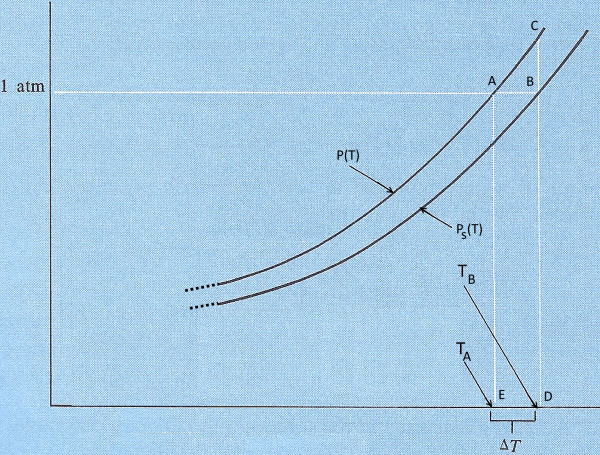





Call the solvent $B$ and $A$ the solute. Let $ X_A$ be the mole fraction of the solute. - $ X_A$ is small, since the solution is diluted! - The study of the saturated vapour pressure shows that low volatile substances have at any temperature low saturation vapor pressures, so $ P_{oA} $, saturation vapor pressure of $A$ is minimal. Then: $P_A$ $=$ $X_A\;P_{oA}$ is negligible at any temperature. Raoult's Law for a given temperature is simplified in this case:
$P_s$ $=$ $X_B\;P_{oB}$ $=$ $\;P$ (*) where $P_s$ is the total vapor pressure of the solution $X_B$ the mole fraction of solvent $ B $ $P$ the saturation vapor pressure of the pure solvent $B$
Example
Calculate the vapor pressure at $25\;şC$ of a solution that contains $0.400\;mol$ of sugar in $500\;g$ of water. The saturation vapor pressure of water at $25\;şC $ = $23.5\; mmHg$ ..
For a given solution ($X_A$ and $ X_B$ fixed), graph of function $P_s(T)$ can be constructed step by step with (*) , starting from the → saturation vapor pressure graph $P(T)$ of the pure solvent :

As the function $P(T)$ is (apparently) continuous and differentiable in the diagram portion represented, we can use the mean value theorem: $P(T_B)-P(T_A)$ $=$ $P^{`}(T_i)(T_B-T_A)$ where $P^{`}(T_i)$ is the derivative at an intermediate point between $ T_A $ and $ T_B$ and therefore equal to a constant $k$ Seen on the diagram: $DC-EA$ $=$ $k(T_B-T_A)$ $BC$ $=$ $k(T_B-T_A)$ $P(T_A)-P_s(T_A)$ $=$ $k(T_B-T_A)$ $P(T_A)-X_B\;P(T_A)$ $=$ $k(T_B-T_A)$ (*) $P(T_A)(1-X_B)$ $=$ $k(T_B-T_A)$ $X_AP(T_A))$ $=$ $k(T_B-T_A)$ $(T_B-T_A)$ $=$ $\frac{P(T_A)}{k}X_A$ where $P(T_A)$ $= $ $1 \;atm$ $(T_B-T_A)$ $=$ $\frac{1}{k}X_A$ (**)
The increase in the boiling temperature of an ideal dilute solution of a nonvolatile solute $A$ is proportional to the mole fraction of solute: $\Delta T = K \cdot X_A$
Quantities
A $0.1\;M $ dilute solution of glucose in water contains per liter $55.5$ moles of water and only $0.1$ mole of glucose!
Approximation
To a dilute solution of a solute $A$ in solvent $B$, the number of moles of solute $A $ are neglected in the expression of $X_A :$ $X_A$ $=$ $\frac{n_A}{n_A+n_B}$ $\approx $ $\frac{n_A}{n_B}$ $= $ $\frac{M_B\;n_A}{m_B}$ $= $ $\frac{M_B}{1000}\frac{1000\;n_A}{m_B}$ $=$ $\frac{M_B}{1000}\mu_A$ where $\mu_A$ is the molality of $A$ $M_B$ is the molar mass of $B$ $n_A$ the number of moles of $A$ $n_B$ the number of moles of $B$ $m_B$ the mass of $B$ in grams In this case it follows from (**): $\Delta T$ $=$ $K\cdot\frac{M_B}{1000}\mu_A$
The increase in the boiling temperature of an ideal dilute solution of a nonvolatile solute $A$ is proportional to the molality of the solute: $\Delta T=K_{eb}\cdot \mu_A$ $K_{eb}$ is the ebullioscopic constant that depends on the solvent only.
Ebullioscopic constant in $\frac{^o}{mol}$
| Solvent | Name | $K_{eb}$ |
| CH3CO2H | Acetic acid | $3.07$ |
| CH3COCH3 | Acetone | $1.71$ |
| C6H5NH2 | Aniline | $3.22$ |
| C6H6 | Benzene | $2.53$ |
| CS2 | Carbon sulfide | $2.37$ |
| CCl4 | Carbon tetrachloride | $4.95$ |
| CHCl3 | Chloroform | $3.66$ |
| C6Hl2 | Cyclohexane | $2.79$ |
| (C2H5)2O | Ethyl ether | $1.82$ |
| C10H8 | Naphtalene | $5.8$ |
| C6H5NO2 | Nitrobenzene | $5.26$ |
| C6H5OH | Phenol | $3.04$ |
| C2H5OH | Ethanol | $1.22$ |
| H2O | Water | $0.512$ |
Example
A solution $s$ contains $0.124\;mol$ of a non-volatile solute in $250\;g$ water. Calculate its boiling temperature $T_s$.